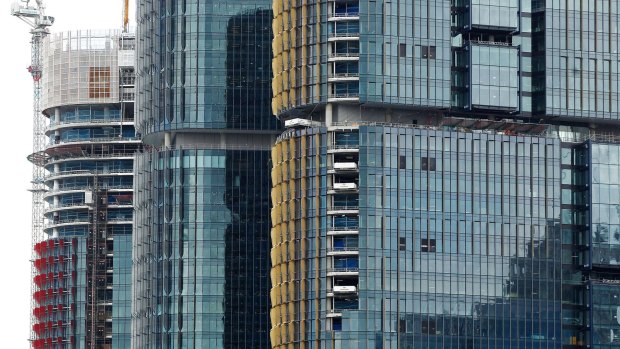This was published 7 years ago
Modern buildings soon to be a shadow of themselves
By Peter Black
Over the next 10 years we will see the design of commercial office buildings change due to a number of influencing factors from tenants.
Fuelled by the demands of a new breed of occupiers, and to stay competitive, developers and architects will design and build commercial buildings differently. The structure of future commercial office buildings will be thinner, lighter and more adaptable resulting in a large number of existing and even new buildings becoming obsolete.

Buildings under construction at Lend Lease Group's Barangaroo redevelopment in Sydney, Credit: Bloomberg
Premium occupiers are becoming savvier in the way they evaluate how a building will perform for their organisation. Close access to natural light and external views are high on an occupier's list of priorities, which is no surprise given today's strong focus on wellness in the workplace. "Thick" buildings have deep spaces, with occupiable space more than nine metres from a window, and low natural light penetration. Hence thick buildings are continually eliminated from the building selection process early on.
Occupiers value connectedness and are drawn to a workplace that connects visually and spatially, supports engagement, promotes collaboration and provides a high sense of community. Therefore building structures will need to become much more adaptable and flexible to accommodate open stairs, voids and atriums in multiple locations.
Colliers research has shown that personal paper storage can go upwards of 11 lineal metres per person in old-style workplaces. In moving towards the reality of a paperless office, new workplaces are only allowing enough paper storage to fit into a personal locker. Wi-Fi is now ubiquitous and almost everyone has a laptop or mobile.
As recently reported in The Sydney Morning Herald, published by Fairfax Media, wireless charging will continue to improve and eventually untether us from direct power connections. Many occupiers have begun asking why we need emergency power back-up for devices that already have their own battery. With computer rooms increasingly being moved off site away from prime CBD office space, it's hard to believe that occupiers will be willing to pay for space designed for hard power and data cabling, back-up generators and UPS, or heavy loading areas for high-density storage if it's no longer needed. In "thinning" buildings down these spaces will eventually be eliminated.
A new generation of buildings with heightened levels of sustainability, innovation and inbuilt intelligence are beginning to emerge throughout the Sydney CBD; think 200 George Street, Barangaroo and 60 Martin Place. Ten years from now new commercial office buildings will be even more sustainable, innovative, smarter, thinner and lighter to appeal to the occupiers of next decade.
Peter Black is national director of Workplace Strategy and Design for Colliers International.